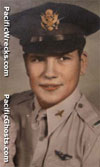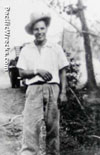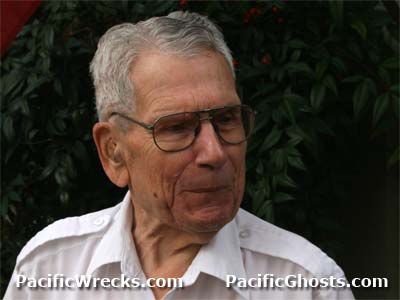Harvey E. Rehrer
P-39 Airacobra, P-38 Lightning and C-47 Skytrain pilot
in New Guinea
In memory: Harvey "Gene" Rehrer passed away October 28, 2010.
I was born in 1916 in Reading PA. During September 1939, I joined the U.S. Army. After arriving in Australia, flew the P-39 Airacobra in Australia then was sent northward to New Guinea. Assigned to the 35th Fighter Group (35th FG), 39th Fighter Squadron (39th FS) flying the P-39 Airacobra from 14 Mile Drome (Laloki) near Port Moresby. He usually flew as part of the 2nd element flying as wingman for Captain Charles King.
 On June 16, 1942 (day of crash of P-39) it was my day off. But, I was "Gung ho" young and dumb and volunteered to fly the patrol, cause one of the other pilots could not fly because he was sick or something. So, I flew it instead, flying a plane [P-39F Airacobra 41-7204] that I did not normally fly. In the air, I was "tail end charlie" the worst place to be. Also, his P-39 had some problem - probably fuel transfer, as the engine was not getting full power. (The wreckage of his aircraft, P-39F Airacobra 41-7204 had the throttle scaled back). We patrolled, and the only thing he knew was he saw tracer bullets from behind him. His plane was hit, luckily he was not. But, the instruments were hit, and the fuel tank (drop tank?) was hit and set on fire. His plane started to disintegrate. On June 16, 1942 (day of crash of P-39) it was my day off. But, I was "Gung ho" young and dumb and volunteered to fly the patrol, cause one of the other pilots could not fly because he was sick or something. So, I flew it instead, flying a plane [P-39F Airacobra 41-7204] that I did not normally fly. In the air, I was "tail end charlie" the worst place to be. Also, his P-39 had some problem - probably fuel transfer, as the engine was not getting full power. (The wreckage of his aircraft, P-39F Airacobra 41-7204 had the throttle scaled back). We patrolled, and the only thing he knew was he saw tracer bullets from behind him. His plane was hit, luckily he was not. But, the instruments were hit, and the fuel tank (drop tank?) was hit and set on fire. His plane started to disintegrate.
I could not release either cockpit door's emergency release, so I kicked out the right door. The wreckage of his aircraft, P-39F Airacobra 41-7204 had the door emergency release intact). As soon as he did, Rehrer was sucked out, and floated outside for a moment. In the process, his prized Australian flying boots were sucked off. (His right right boot was reported by Wilkinson Egimbari in the cockpit.
That was the last he saw of his plane. He though he had forgotten to put on a parachute and thought he was going to die. Instinctively, he reached up and pulled the rip-chord and parachute opened... when it opened, the jolt dislocated his shoulder. As he descended, he entered a cloud, and this was good, because otherwise the Japanese would strafe his chute, as he had seen them do already in combat.
He landed in the jungle, and must have been near his crashed plane, as he thought he heard the sound of ammo cooking off and exploding. He did no search for it, and never saw it. He started to walk... he followed the Brown River, and climbed ridges to save time, but the climbing always exhausted him and took longer. He was lost in the jungle for 6 days. He had three problems: dislocated shoulder. He got malaria and 'the worst case of hemorrhoids i have ever had'.
 On the 6th day, he came to a village. The village was in a festive mood because they were having a celebration (because someone had died (?) The people at 'brown river village, located on the west bank of the river were very friendly, and one person spoke decent English. He was treated very well. He had lost 40 lbs in the jungle and his clothes were in tatters. They put him into a 'tent', with woven mat floors and gave him special clothes made from jungle materials to wear. He said the clothes were very comfortable. They gave him food and let him sleep for the night. He said the USAAF had been releasing leaflets around Port Moresby and New Guinea, telling natives that if they found an American flier, he was very valuable, and if they returned him to Port Moresby, they would be rewarded handsomely. Harvey said the Brown river people seemed to have gotten one of these fliers and were very happy about their good luck, and treated him like royalty. On the 6th day, he came to a village. The village was in a festive mood because they were having a celebration (because someone had died (?) The people at 'brown river village, located on the west bank of the river were very friendly, and one person spoke decent English. He was treated very well. He had lost 40 lbs in the jungle and his clothes were in tatters. They put him into a 'tent', with woven mat floors and gave him special clothes made from jungle materials to wear. He said the clothes were very comfortable. They gave him food and let him sleep for the night. He said the USAAF had been releasing leaflets around Port Moresby and New Guinea, telling natives that if they found an American flier, he was very valuable, and if they returned him to Port Moresby, they would be rewarded handsomely. Harvey said the Brown river people seemed to have gotten one of these fliers and were very happy about their good luck, and treated him like royalty.
The next morning, his seventh day, they loaded him onto a donkey and crossed the river and escorted him to Laloki arriving at the end of the day. When he was reunited with his squadron at 14 Mile Drome, it was a big event. All his Squadron mates were very happy to see him, when he was lost, another pilot had only seen him go down in flames and nobody saw him bail out and they assumed he was killed in the air combat or crash. Naturally, everyone was very happy to see him!
The locals who brought him back were very surprised too. The Americans loaded up their two donkeys with two large packs full of all the food they could carry. The locals asked for three times: Epson Salt, Table Salt and flour, Harvey remembered, but they got everything the 39th had in their mess plus tons of cigarettes. Everyone was happy and they rode off into the night with two overloaded donkeys back to Brown River.
Afterwards, Harvey was briefly hospitalized at the 12th Station Hospital at Townsville. There, he met Norma who he later married. After recovery, he returned to 39th and flew more combat missing and transitioned to fly the P-38 Lightning and flew five or six missions in the new fighter. One of his P-38 missions was to Rabaul, flying over the open sea and all those mountains, he got worried, "I was afraid of having to bail out again and being lost in the jungle. I was not afraid of flying, but i wanted to fly a plane with a crew. I did not want to walk in the jungle alone again." His buddies in 39th Fighter Squadron were shocked and chastised him when he put in papers for a transfer to bombers. According to them, why would anyone not want to fly the P-38, the best fighter plane in the world!
When his transfer was granted, and Rehrer was assigned to the 374th Troop Carrier Group (374th TCG), 6th Troop Carrier Squadron (6th TCS) flying the C-47 Skytrain transporting cargo and personnel in New Guinea. During February 1944 he became the Commanding Officer (C.O.) 6th Troop Carrier Squadron (6th TCS) until September 15, 1944 and remained with the squadron until the end of the Pacific War. Aside from one landing when he blew a tire landing, he flew C-47s on hundreds of missions without incident.
Postwar
 Rehrer remained in service and continued in the U.S. Air Force (USAF) for the remainder of his military career including five overseas tours, all in the Pacific region and was promoted to the rank of Lieutenant Colonel. He retired in Sacramento where he was active in a Railroad Appreciation Club, narrates the Amtrack train tour from Sacramento to Reno and enjoys gardening. In his bedroom is the framed photograph of Rehrer wearing the clothes the Brown River villagers gave him when he was rescued. Rehrer remained in service and continued in the U.S. Air Force (USAF) for the remainder of his military career including five overseas tours, all in the Pacific region and was promoted to the rank of Lieutenant Colonel. He retired in Sacramento where he was active in a Railroad Appreciation Club, narrates the Amtrack train tour from Sacramento to Reno and enjoys gardening. In his bedroom is the framed photograph of Rehrer wearing the clothes the Brown River villagers gave him when he was rescued.
Memorials
Rehrer passed away October 28, 2010 at age 94.
References
Logbook Harvey E. Rehrer June 16, 1942
FindAGrave - LTC Harvey Eugene “Gene” Rehrer (photos, obituary)
The Sacramento Bee - November 7, 2010
"REHRER, Harvey Eugene ''Gene'' Passed away peacefully surrounded by his family and friends October 28 in Sacramento, two months shy of his 94th birthday. A pilot in WWII, Gene served 25 years in the US Air Force and was awarded the Distinguished Flying Cross, the Air Medal, and Purple Heart. His plane was shot down over New Guinea during the war and was discovered in 2006 by Justin Taylan, of PacificWrecks.com. He moved to Sacramento in 1964 where he owned and operated several businesses and was a member of the Masons and Scottish Rite. A dedicated volunteer docent at the California Railroad Museum for over 20 years, Gene grew up loving trains and was recently presented with a Conductor's Cap by Amtrak staff, for over a decade of volunteer work riding the rails from Sacramento to Reno describing the history of each spot along the way to passengers. Born in Reading, PA, son of Paul L. and Rhea Rehrer, Gene is survived by his wife of 68 years Norma, son Lawrence and wife Ann, daughter Diane, nephew Robert Rehrer and wife Marcia, and great niece Jennifer. Memorial services will be held at 2 pm November 13 at Fremont Presbyterian Church, 5770 Carlson Drive at the corner of H Street in Sacramento (park at Scottish Rite Center across the street). Donations can be made to Fremont Presbyterian Church, St. Michael's Episcopal Church, or charity of choice"
-141 Flying Squadrons - 6th Airlift Squadron / 6th Military Airlift Squadron / 6th Troop Carrier Squadron
"Commanders... Maj Harry [sic Harvey] E. Rehrer, c. Feb 1944"
Thanks to Harvey E. Rehrer for additional information
Contribute Information
Do you have photos or additional information to add?
|